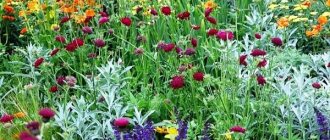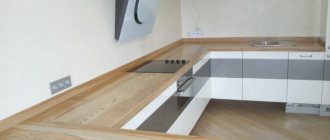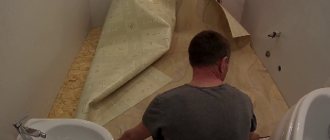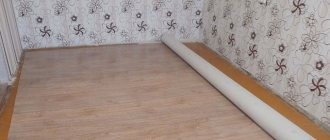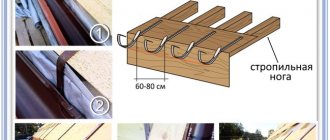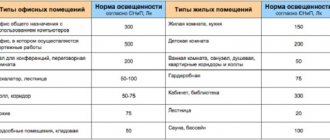What is artificial turf
Artificial turf grass is a synthetic surface. The basis of artificial turf is polypropylene. “Blades of grass” (synthetic threads), which are coated with silicone, are attached to the base in a vertical position. There is a rubber backing at the bottom. Drainage grooves are laid at the top so that snow and rain water does not linger on the surface, but flows off the surface.
Artificial lawns today are produced of high quality; they look similar to natural grass.
Most often, such synthetic coating for landscaping is sold in rolls. The roll form of the grass makes it much easier to lay.
Synthetic fibers are attached to the artificial turf base during its production process. Depending on the purpose of the lawn, the blades of grass have different densities and thicknesses.
Most often, the villi reach a height of 6 to 10 centimeters.
The color range is also extensive - you can choose any shade of grass for your lawn.
Artificial lawns are divided according to the laying principle:
- non-filling;
- half-fill;
- backfill.
Non-fill artificial lawns
This type of lawn always looks very natural and attractive; it is difficult for inexperienced people to distinguish an unfilled lawn from real grass.
This coating is used when decorating areas where almost no one walks.
They try to fence off such a lawn, since when walking on it the grass will not “live” for a long time.
Half-fill
Such synthetic “grass” coverings are intended for the design of all kinds of playgrounds and children’s playgrounds, sports (football, for example) fields.
The base of the lawn is made from very soft polyethylene threads, which significantly soften the impact of a fall.
When buying a semi-fill lawn, you must pay attention to the quality and strength of the material.
When laying, the spaces between the fibers are filled with quartz sand.
Backfill
Artificial infill lawns are used for landscaping, in addition to summer cottages and home areas, also for laying on football fields. When using a semi-fill lawn, it is evenly sprinkled with quartz sand with a fraction of up to 0.6 mm.
In addition to sand, rubber granulate is needed for laying a backfill lawn.
This material perfectly protects against bruises and injuries from any falls.
Fiber type
The first types of artificial lawns had fibers that took the form of grass only after adding stabilizing compounds between them.
The first types of artificial lawns had fibers that took the form of grass only after adding stabilizing compounds (special sand or rubber granules) between them. This artificial grass was called fibrillated and had low elasticity and wear resistance. Over time, manufacturers replaced fibrillated “blades of grass” with another type of pile - monofilament. It is elastic, that is, it maintains its original vertical position for a long time, and stabilizing bedding is not necessary for this, although it is used on some types of specialized artificial lawns.
Monofilament fibers are much more pleasant in terms of tactile sensations, in which they are almost as good as natural lawn grass. This pile is resistant to wear and tearing. The length of the fibers and their density per unit area of coverage depends on the purpose of the “grass” carpet. Carpet that does not require adding sand or rubber granules ranges from 4-8 mm. Some specialist artificial turfs can have a pile length of up to 70mm (for indoor rugby pitches, for example). The density of the pile is determined in grams per m2 of green covering. Inexpensive carpets have a density of 250-500 g/m2, elite ones - from 1.5 g/m2 and higher.
Advantages and disadvantages of artificial turf
All synthetic lawns have advantages, including the following:
- spectacular and aesthetic grass covering lasts for a long time;
- the lawn is used in open and closed areas throughout the year;
- the coating is highly resistant to all kinds of natural factors;
- artificial turf protects any area from the growth of weeds;
- “grass” is not afraid of excess moisture;
- Artificial turf is not difficult to maintain;
- “grass” does not need regular watering and fertilizing, unlike a real lawn.
Among the disadvantages is the very high price of the material. If the cost of artificial turf is low, then most often it is of poor quality.
An unpleasant fact during operation will be the heating of the lawn at high temperatures.
After all, the coating is based on synthetic fibers, and they tend to heat up under the rays of the sun. And the last drawback is that if you get tired of the old artificial turf, it will take a lot of time to replace it with a new lawn.
How to care for artificial lawn
Before laying artificial grass, be sure to familiarize yourself with the rules for caring for it. There are no difficult aspects of care; it is enough to follow the basic requirements. Due to the fulfillment of the conditions, the service life of artificial lawns is significantly increased.
- The lawn must be used for its intended purpose. If the artificial turf is intended for decorating a summer cottage, playing field, etc., then there is no need to subject it to increased mechanical loads as a result of everyday use.
- To connect the seams, you need to purchase a special glue that will fix the strips very firmly. It is better not to use cheap glue.
- The finished artificial turf must be washed and dirt removed regularly. Especially that “grass” that covers the playground.
- It is necessary to minimize the entry of construction and household waste onto the lawn, since ideally removing it from the surface will be problematic.
- Once every six months, it is recommended to replace quartz sand and granules in semi-filled and infill lawns.
- Since there is no point in leaving a lawn on the site in winter, the rolls are removed until spring.
- When an artificial lawn is used quite often, it will have to be updated more often.
- If for some reason the lawn covering is damaged, the damaged area is isolated until it is completely restored. There is no need to allow the problem to worsen and continue to exploit this area.
- Once a week, the grass is slightly moistened, especially if the weather is too hot.
- Every two weeks, punctures are made in the artificial turf. This way you can protect your lawn from mold.
- Weeds sprouting from under the “grass” must be removed; they must not be allowed to grow on the surface of the lawn and disturb the evenness of the surface.
Do not install objects that are too large or heavy on the artificial turf as they could deform the pile and ruin the appearance of the lawn.
It is forbidden to drive onto surfaces with synthetic grass by motorized or motor vehicles.
The exception is special cleaning equipment.
You can rid your lawn of dirt using plain water. To remove leaves, you need a special rake. You can use a vacuum cleaner. But if the lawn is backfilled, then you won’t be able to use a vacuum cleaner, since it will begin to collect filler (quartz sand).
It is important to monitor the condition of the “blades of grass”, check the seams in order to notice the separation in time and solve this problem.
What you need to lay a lawn
To lay synthetic lawn, you will need the following materials:
- artificial turf;
- seam tape;
- polyurethane glue (two-component);
- substrate for coating;
- sand;
- putty knife;
- brush for removing glue;
- knife.
Artificial turf is laid on different substrates: soil, concrete, wood, brick.
Laying lawn on a concrete surface
Sometimes a concrete foundation needs to be installed on a site. Most often these are the following areas: a children's playground, an open terrace, a balcony in an apartment.
Most often, the design of a concrete base is carried out only in certain areas.
To glue the synthetic coating to concrete, you will need a backing. This will make your lawn last a couple of years longer.
As a substrate, you can purchase geotextiles or rubber coating.
Before laying the covering, the concrete base is cleared of debris. Then lay out the required amount of substrate. After that - lawn grass in rolls. There must be an air cushion between the substrate and the coating.
It's good when the base is made of polyester. It is necessary to ensure that the layers overlap each other by approximately 15 mm.
After this, the substrate and the lawn should rest until completely straightened. Then the materials are glued together using polyurethane glue and connecting tape.
If the lawn covering is laid using the semi-fill or backfill method, then additional backfilling with quartz sand and rubber granules is required. All edges are decorated with small borders.
Marking
If the artificial turf will be used as a sports ground, then markings will be necessary. This can be done in two ways:
— painting;
- “inset”;
The first option is more economical and easier to implement, but less durable. Such markings, applied with polyurethane paint, will last from 3 to 5 years.
The second option is more labor-intensive, but the service life of such markings is equal to the service life of the site itself. It involves inserting markings made of the same artificial grass, only white.
To install the ribbon, strips of the required thickness are cut from white blades of grass on a green field. Then a connecting tape is placed under the resulting edges of the lawn, polyurethane glue is applied to it, and the edges of the lawn and the white marking insert are carefully placed, avoiding the glue getting on the fibers. Everything is pressed carefully.
Laying lawn “grass” on the ground
Installing an artificial lawn on the ground is a painstaking job and will require a lot of patience and effort. But the result is worth it!
To begin with, a plot of land is prepared. It must be completely clear of debris and weeds. Then the area is leveled.
Then the required number of rolls for their purchase is calculated.
When laying turf, it is important that the ground is completely dry. If there are unevenness on the base of the soil, they are leveled. Do not lay the coating on areas with sand. There is a high risk that the “grass” will deform very quickly.
It is important to make several outlets for water under the coating.
The grooves will save the lawn grass from rotting. In addition to the grooves, a drainage layer of granite or crushed stone is also laid out.
When the area is prepared, begin rolling out rolls of artificial turf. The rolls are stacked tightly to each other.
The rolled out lawn covering is left in this form for a day so that the lawn takes on the correct shape.
Then all seams are rolled with a special roller. Seam tape is often used. It is secured at the joints using staples or glue.
For laying lawn grass on the ground, it is best to purchase the infill type. After laying, the entire lawn is covered with quartz sand.
Reviews
We installed artificial turf next to the pool and couldn't be happier. The water disappears instantly. It is non-slip, pleasant to the touch, and not prickly. We had the installation done by specialists, so there are no questions. The surface was pre-leveled and everything lies very smooth and beautiful.
Michael
They made a playground in front of our house. Initially, the ground around it was sprinkled with sand and crushed stone. Children were injured while sliding down the slide. Then my neighbors and I decided that this needed to be fixed somehow and ordered an artificial grass lawn. This is just a miracle. It is soft and absorbs shock. Children run on it, fall and everything is fine. Doesn't fade in the sun, excellent quality.
Elena
I always really wanted to have a lawn everywhere in my yard.
One year I sowed the seeds, the next year everything seemed to germinate well, but in the heat the lawn burned out badly. I began to water it very often, and then the result improved. In the places where we usually sit, the grass began to disappear. In general, I suffered with him. This year we bought artificial turf. Very pleased. Durable, beautiful, does not fade in the sun, no need to water. Larisa
Laying artificial grass on wood flooring
The technology for installing synthetic lawn grass on wood flooring completely depends on the type of material.
Rolls or pieces can be secured using safety brackets, special glue or adhesive tapes.
There are options when artificial turf is “laid” on a wooden wall.
Before laying the lawn on a wooden surface, it is thoroughly cleaned of dust and debris and treated with anti-corrosion impregnations or primers.
In a natural way, the dried base is thoroughly coated with special glue and pre-unwound rolls of lawn covering are glued. They are placed with a slight overlap (up to 15 mm).
The rolls are then cut and sealed with seaming tape to create a perfectly even lawn. For reliability, you can use staples at the joints. You can also install a border made of building materials around the entire perimeter of the lawn.
Installation of artificial grass on a football field
For a football field, infill turf with a pile of 2 to 5 cm is used.
The process of laying artificial turf on a football field:
- Correct laying of the coating begins from the moment the rolls are unloaded. The better the artificial grass is preserved during the installation process, the longer the football field will last. Rolls of synthetic turf are unloaded as carefully as possible. You can use a forklift for unloading, having a pin three meters long and 10 cm in diameter.
- Artificial turf is laid on a hard base and on a sand and gravel base. For a football field, it is important that an elastic and durable substrate be laid, with a thickness of at least 0.8-1 cm. If you use a thinner substrate, you will not be able to lay out the lawn evenly, and bends cannot be avoided.
- When the substrate is prepared, rolls begin to roll out. The rolling out process must be carried out in strict accordance with the field plan. After rolling out, the lawn grass is left to rest for 10 hours. During this time, the artificial grass will fully expand and the rolls will take the shape of the field.
- The lawn sheets are laid with an overlap of 15 mm, then the edges are cut so that the rolls fit millimeter to millimeter.
- When they achieve an even and precise fit at the joints of the rolls, they begin to glue the different parts together. It is important to remember to trim the edges. Then the edges of each canvas are turned back and a connecting tape is laid. The junction of the canvases should be in the middle of such a tape.
- Polyurethane two-component adhesive is applied with a spatula. After applying the glue, the edges of the canvases are carefully lowered. Before the glue completely hardens, you need to lift up all the fibers that accidentally bent inward. Each seam must be rolled using a roller.
- Not all fields have marking lines sewn into them. Then the line must be sewn in, but only when the grass cover has completely stuck together. Sewing requires strips and a double-bladed tool. You will need it to complete the markings. Coat the strips with glue, and then carefully insert the strips.
- The next stage is filling the lawn grass with sand. Use quartz sand with a fraction of 0.3-0.6 mm. Filling is carried out in dry weather. In accordance with the norm, sand is consumed per 1 m2 and distributed evenly throughout the lawn. Then the grass is combed. During this procedure, the sand will settle.
- The last stage when installing artificial grass on a football field is additional filling with rubber granules, followed by combing the lawn surface. It is better to use rubber or rubber granules with a fraction of 1-3 mm. If you use the football field regularly, you will have to repeat the filling with granulate after 4-6 months.
The permissible air temperature at which it is allowed to operate a football field is from –30ºС to +50ºС.
Infill synthetic lawn must be regularly cleaned of debris; do not forget to remove debris with a rake several times a year.
Gluing the canvas
Once you are sure that the lawn fabric lies flat and has no defects in the form of swellings or bumps, you can begin gluing the parts together.
To glue parts of the lawn together, special connecting tapes (sutures), about 30 cm wide, and polyurethane glue are used.
The tape is placed under the edges of adjacent parts, glue is applied to it with a notched trowel, the edges of the sheets are lowered, and the seams are pressed with a roller or heavy pipe of a suitable diameter.
The work should be done carefully, avoiding getting glue on the lawn fibers.
If the lawn area is large, it is advisable to additionally secure the seams with staples.
Laying artificial grass at the dacha
Installing an artificial lawn at your dacha is no different from laying artificial turf on the ground. The soil base is prepared in the same way. Don’t forget to drain the water so it doesn’t accumulate under the artificial lawn.
A drainage layer is also made from crushed stone (or granotsev).
After laying the rolls, they are left to rest for a day and take on a new straightened shape.
It is recommended to secure the edges with a mounting stapler.
For the winter, the rolls can be carefully rolled up by removing all the staples. You only need to roll up a dry covering, otherwise there is a risk that it will become moldy over the winter.
If the lawn covering is left to winter, then when the ice freezes, you cannot scrape it off the surface of the lawn with a shovel. This will lead to damage to the coating; such areas may need to be replaced in the spring.
Artificial turf is a great innovation and a good alternative to natural grass. Artificial turf is easier to maintain, it does not wither or grow. It is enough to decorate the area with artificial grass once, and the lawn will decorate it for many years.
Substrate preparation
The soil for lawn grass should be loose and porous with a neutral acidity level. The substrate can be purchased at a specialized store, or you can prepare it yourself. To do this you will need sand, silt and clay in proportions of 2:2:1. At the bottom of the box it is necessary to lay out a layer of drainage made of expanded clay, balls, pebbles or other materials. The drainage components should be doused with boiling water for disinfection purposes, and the substrate itself should be calcined.

